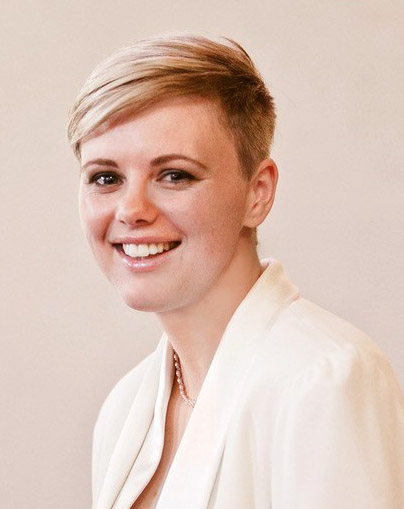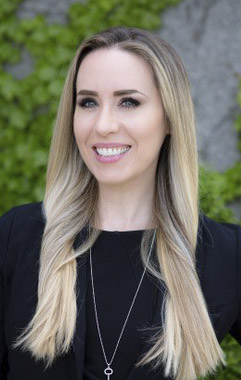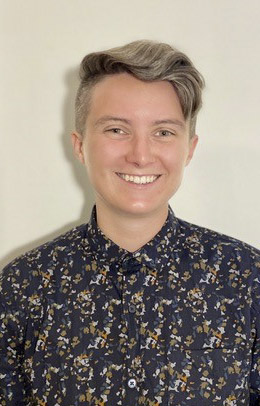
Dr. Karen Blair

Dr. Rhea Ashley
Hoskin

Bre O’Handley
Dr. Karen Blair, Dr. Rhea Ashley Hoskin, and Bre O’Handley Sexual Orientation and Gender Identity Section
The field of Sexual Orientation and Gender Identity in psychology has come a long way in the last few years, from securing same-sex marriage rights to banning conversion therapy. We spoke to Dr. Karen Blair, Dr. Rhea Ashley Hoskin, and Bre O’Handley about that progress, and about a term you may not have heard before – “femmephobia”.
Sexual Orientation and Gender Identity
“I don’t like beer anymore”
There’s a commercial running on TV where a guy confesses to one of his buddies, in an ashamed whisper, that he no longer enjoys the taste of beer. There is an implicit understanding between us, the viewers, and the guys in the commercial, that disliking beer is affecting that guy’s sense of masculinity. That enjoying beer with the boys is a part of his male identity that he is ashamed to lose. And that disliking beer makes him more ‘feminine’, and therefore less worthy, than the others.
Dr. Rhea Ashley Hoskin is an AMTD Global Talent Postdoctoral Fellow at the University of Waterloo, where she is cross-appointed to the departments of sociology and legal studies and also sexuality, family, and marriage studies. She is the secretary/treasurer of the CPA’s Sexual Orientation and Gender Identity Section (SOGI), and her work broadly looks at sexual and gender diversity – more specifically, societal treatment of femininity and “Femmephobia”.
“Femmephobia is about the way society devalues and regulates femininity, which can target anybody. It can target a cisgender man who orders a salad, or is seen somehow as being feminine – because femininity is often viewed as a social demotion. We also see femmephobia targeting women in science who might be seen as ‘too feminine’ and might be treated as though they are incompetent because they wear too much makeup or because they ‘don’t look like a scientist’.”
In the commercial, the guy’s buddy treats his announcement of no longer liking beer with a shrug and doesn’t seem to think this makes Guy One any less of a man. Then, of course, he offers him something in place of the beer – a hard liquor that we, the viewer, can infer to be an adequate replacement and equally manly in the eyes of society.
Femmephobia affects both gay and straight people, both men and women, and even those who identify as non-binary – the push and pull of defining your public persona through what is seen as feminine is something we all carry with us, mostly subconsciously. Every one of us is touched by it in some way, whether it’s men who order a regular beer instead of a light beer, for fear of seeming too ‘feminine’, or women who wear less makeup to appear more intelligent or ‘professional’.
Dr. Karen Blair is an assistant professor of psychology at Trent University, and has been the Chair of SOGI since 2014. She says,
“One of the neat things about Femmephobia is that once it clicks, you begin to see it everywhere. You start noticing all the different ways we devalue femininity. With men, we have a pretty narrow range of “acceptable femininity” – and in most cases, we prefer they have none. In the football locker room when a coach wants to insult a team, he might say they played ‘like a bunch of girls’. That’s meant to sting, and the players get the message that the coach is unhappy. If a man walks too ‘feminine’ or talks too ‘feminine’ or talks with his hands, we take him down a notch for it. We use femininity in our society as a weapon or an insult.”
With the occupation in Ottawa getting under way a couple of weeks ago, attacks on the Prime Minister increased notably – both within the group of insurrectionists and also on social media. Dr. Blair and Dr. Hoskin track this sort of thing. What do attacks on public figures and politicians look like, and how is Femmephobia so often a part of them?
“When people want to attack Justin Trudeau, they do a few things – one, they tend to call him by his first name. When we were upset at Stephen Harper, we still called him Harper. But when we’re upset with Trudeau, we use his first name – and some even call him Justine. Why should it be an insult to call someone by a woman’s name? Why is it insulting to feminize another person? The answer is misogyny and femmephobia. It’s not just politicians like the Prime Minister, we’ll do this across the spectrum. When people want to make fun of Putin, or Trump, one of the common memes on the internet is to add makeup to their faces to make them look like an overdone woman. No matter how you feel about Trudeau, Trump, or Putin, they’re all taken down with this same attack of ‘femininity’. It’s used to say they’re lesser, they’re stupid, they’re silly, they’re frivolous, or they’re extreme. All these things can be conveyed just by making them feminine. Which leaves you wondering – what are we actually saying about people who are feminine? It’s kind of like when people used to say ‘that’s so gay’, when what they meant was that something was stupid, or silly.”
‘We’ (society) have come a long way in the last few decades. When the SOGI section started it was the early 2000s, and one of the big pressing issues at the time was same-sex marriage. The extension of civil rights in Canada to same-sex couples was top of mind for many psychologists, and there is a policy statement from the CPA at that time stating our support for this notion of same-sex couples having the right to marry one another. It seems a little quaint today – like, of course we support that – but Dr. Blair says that at the time it was quite a novel and exciting statement.
“A lot of the research at the time, the early 2000s, was showing that same-sex relationships were the same as mixed-sex relationships in that they’re good for people, and healthy, and that love is love. These were the kinds of things researchers were focused on. They were trying to support policy-makers in understanding that when people are cut out of an institution like marriage, it changes the relationships they have with their family, their friends, and their coworkers. For instance, consider something as silly as holiday parties at a company where invitations are extended to include spouses. If you were a same-sex couple in 1999, it would be really unclear as to whether your partner was included, and in some cases it would be quite explicit that they were not.”
Many people at that time felt like they couldn’t talk about their partners at work or couldn’t have a photo of them on their desk. Psychologists working in this space were able to point out how things like that took a toll on peoples’ mental health and their well-being over time. Dr. Blair continues,
“A lot of research showed that families of LGBTQ people didn’t really ‘get it’. And that they really didn’t get it right up until the moment they were at the wedding. At a wedding there are social scripts that tell us when to get up, when to clink our glasses, when to applaud, and so on. Being able to put same-sex relationships into this social ritual that people understood created a situation where family and friends could understand the relationship – which then led to greater support from the inner circles of many LGBTQ individuals – which then led to greater mental well-being for the whole community.”
That mental well-being has taken a hit during the pandemic, for a variety of reasons. Bre O’Handley is a Master’s psychology student at Trent with Dr. Blair as her supervisor. She is working on a thesis that looks at LGBTQ well being during the pandemic and how supports might play a role in that.
“I’m looking at the trajectories of well-being for LGBTQ people during COVID. There’s a lot of research all over the world that has found that LGBTQ people are faring worse during this pandemic. Their mental health has been affected more, they’re reporting higher levels of depression, anxiety, and stress. Everybody’s experiencing COVID and social isolation, but there are additional factors that could impact LGBTQ people. They could be living in an unsupportive environment, especially if they’re younger. They’re being separated from affirming communities – like if you had a group of friends at school who supported and accepted you, but now you’re not going to school. The pandemic reduced access to LGBTQ resource centres. For a long time, trans people were unable to get hormone replacement therapy (HRT) and gender-affirming surgeries, as those were deemed non-essential at the beginning of the pandemic and supply chain issues delayed shipments of important drugs and hormones.”
There were even discriminatory COVID policies in a number of countries. In Peru, a rule was instituted that said men could leave the house only some days, and women could leave only on other days. This left trans people, and people who didn’t identify as either male or female, in a significant bind. Many experienced harassment and hate crimes while they were out of the house. Bre’s research doesn’t tackle the discrimination, so much as the supports that are needed for those who are on the receiving end of that discrimination.
“How do we foster resilience in these circumstances, and how are LGBTQ people coping in this pandemic? If I feel connected to the LGBTQ community, that should buffer some of the issues that affect mental health. But how do we separate that out from more general social supports? Is just having supportive people and family around you enough, or do you need that social connection with others in your peer group to truly maintain resilience? This circumstance now, with COVID, gives us a little bit of an opportunity to tease that apart.”
There is always more work to be done, and always new challenges that arise. Same-sex marriage has now been the law of the land in Canada for sixteen years. Adoption by same-sex couples has been legal in all Canadian provinces and territories for a decade. Conversion therapy is now banned, and many members of the SOGI section were actively involved in discussions with policy-makers to make that happen. Today, the focus on gender identity is catching up to the fight for equal rights for gay and lesbian couples. Says Dr. Blair,
“You can know a lot about sexual orientation and sexual minorities and still manage to know nothing about gender identity or gender minorities – and vice versa. The two came together as a CPA section when the topic of gender identity was less prevalent, and the focus was probably more on sexual orientation at that time. Over time, gender has become an equally important topic to sexual orientation within the section.”
All of us in Canadian society are learning a little bit more about sexual orientation and gender identity, just as the scientists are learning more and telling us about it. Dr. Hoskin frames this in terms of Femmephobia.
“Our ability to see femmephobia comes from the study of sexual and gender diversity. Femmephobia is illuminated by our ability to tease apart gender identity from sex assigned at birth, and gender expression. When we can see those things as different, we can see how gender expression comes into play and how it’s regulated by society.”
We all form part of that society, and how we regulate our attitudes toward the LGBTQ+ population is an enormous part of preserving and enhancing their mental health. It could be using the correct pronouns to address someone, embracing your lesbian daughter, or something as simple as stating with firm confidence,
“I don’t like beer anymore.”
